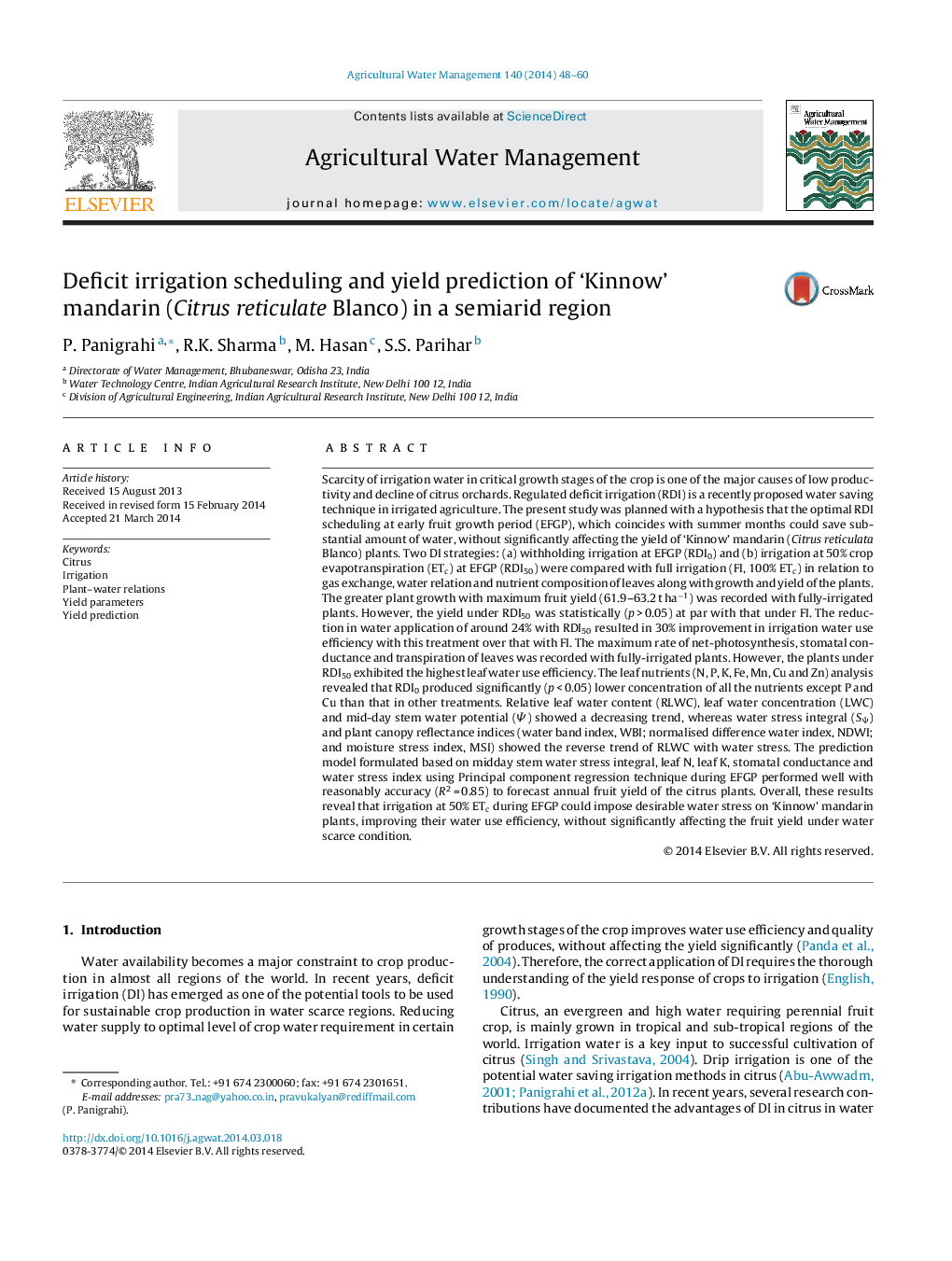| کد مقاله | کد نشریه | سال انتشار | مقاله انگلیسی | نسخه تمام متن |
|---|---|---|---|---|
| 4478647 | 1622939 | 2014 | 13 صفحه PDF | دانلود رایگان |

• Deficit irrigation at 50% ETc at early fruit enlargement period (RDI50) could save 24% water in ‘Kinnow’ mandarin cultivation.
• The fruit yield of the plants under RDI50 was statistically at par with that under full irrigation (FI).
• Fruit quality of deficit irrigated plants was superior to that with fully-irrigated plants.
• The reduction in photosynthesis rate is relatively less than the reduction in transpiration rate of plants under RDI50 compared to FI.
• Principal component-regression has been found as a potential tool to predict the fruit yield of the deficit-irrigated plants.
Scarcity of irrigation water in critical growth stages of the crop is one of the major causes of low productivity and decline of citrus orchards. Regulated deficit irrigation (RDI) is a recently proposed water saving technique in irrigated agriculture. The present study was planned with a hypothesis that the optimal RDI scheduling at early fruit growth period (EFGP), which coincides with summer months could save substantial amount of water, without significantly affecting the yield of ‘Kinnow’ mandarin (Citrus reticulata Blanco) plants. Two DI strategies: (a) withholding irrigation at EFGP (RDI0) and (b) irrigation at 50% crop evapotranspiration (ETc) at EFGP (RDI50) were compared with full irrigation (FI, 100% ETc) in relation to gas exchange, water relation and nutrient composition of leaves along with growth and yield of the plants. The greater plant growth with maximum fruit yield (61.9–63.2 t ha−1) was recorded with fully-irrigated plants. However, the yield under RDI50 was statistically (p > 0.05) at par with that under FI. The reduction in water application of around 24% with RDI50 resulted in 30% improvement in irrigation water use efficiency with this treatment over that with FI. The maximum rate of net-photosynthesis, stomatal conductance and transpiration of leaves was recorded with fully-irrigated plants. However, the plants under RDI50 exhibited the highest leaf water use efficiency. The leaf nutrients (N, P, K, Fe, Mn, Cu and Zn) analysis revealed that RDI0 produced significantly (p < 0.05) lower concentration of all the nutrients except P and Cu than that in other treatments. Relative leaf water content (RLWC), leaf water concentration (LWC) and mid-day stem water potential (Ψ) showed a decreasing trend, whereas water stress integral (SΨ) and plant canopy reflectance indices (water band index, WBI; normalised difference water index, NDWI; and moisture stress index, MSI) showed the reverse trend of RLWC with water stress. The prediction model formulated based on midday stem water stress integral, leaf N, leaf K, stomatal conductance and water stress index using Principal component regression technique during EFGP performed well with reasonably accuracy (R2 = 0.85) to forecast annual fruit yield of the citrus plants. Overall, these results reveal that irrigation at 50% ETc during EFGP could impose desirable water stress on ‘Kinnow’ mandarin plants, improving their water use efficiency, without significantly affecting the fruit yield under water scarce condition.
Journal: Agricultural Water Management - Volume 140, July 2014, Pages 48–60